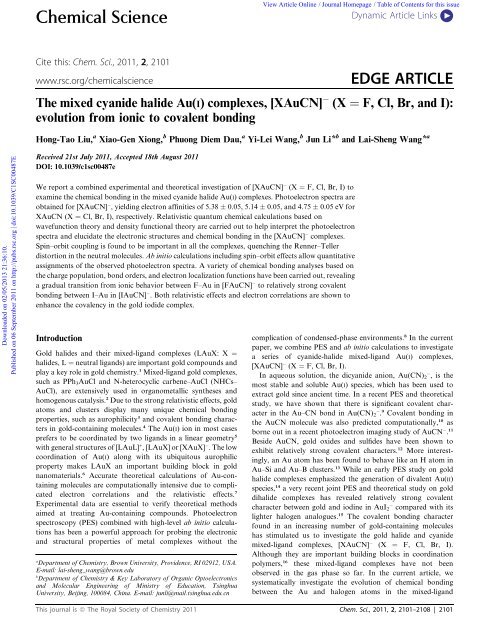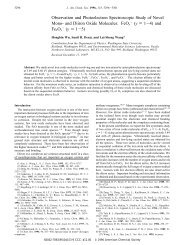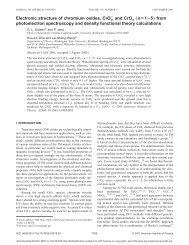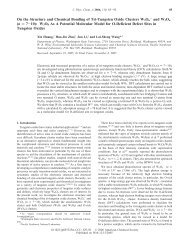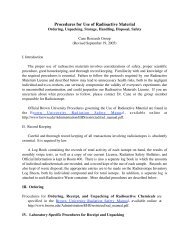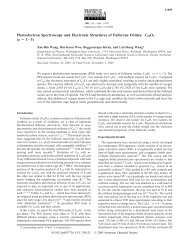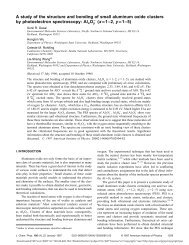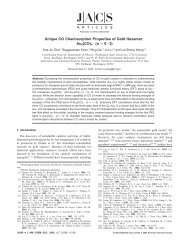Chemical Science EDGE ARTICLE - Chemistry Department at ...
Chemical Science EDGE ARTICLE - Chemistry Department at ...
Chemical Science EDGE ARTICLE - Chemistry Department at ...
Create successful ePaper yourself
Turn your PDF publications into a flip-book with our unique Google optimized e-Paper software.
<strong>Chemical</strong> <strong>Science</strong>View Article Online / Journal Homepage / Table of Contents for this issueDynamic Article Links C
Downloaded on 02/05/2013 21:36:10.Published on 06 September 2011 on http://pubs.rsc.org | doi:10.1039/C1SC00487Ecomplexes, [XAuCN] (X ¼ F, Cl, Br, I). Density functionaland ab initio wavefunction calcul<strong>at</strong>ions are carried out on thefour [XAuCN] species to help spectral interpret<strong>at</strong>ion andchemical bonding analyses.Experimental methodThe experiment was carried out using a magnetic-bottle type PESappar<strong>at</strong>us equipped with an electrospray ioniz<strong>at</strong>ion (ESI) sourceand an ion trap time-of-flight mass spectrometer. Details of theappar<strong>at</strong>us have been described elsewhere 17 and only a briefdescription is given here. All the [XAuCN] anions (X ¼ Cl, Br,I) were produced by ESI from 0.1 mM solutions of KAu(CN) 2mixed with the corresponding potassium halides (KX) ina methanol/w<strong>at</strong>er (90/10) solvent. The anions of interest wereselected by a mass g<strong>at</strong>e and deceler<strong>at</strong>ed before being interceptedby a probe laser beam. The photodetached electrons wereanalyzed by a 2.5-meter long magnetic-bottle time-of-flight tube,modified from the original design. 17 As shown below, theshortened flight tube does not affect the electron energy resolutionsignificantly. Similar experiments using KF did not producethe [FAuCN] anion and no experimental d<strong>at</strong>a was obtained forthis species. In general, it appears th<strong>at</strong> Au(I) does not formcomplexes with F ligands. For example, we were not able toobserve AuF 2 complexes previously while AuX 2 complexeswith heavier halides were readily observed. 14,15Two laser systems were used for photodetachment in thecurrent investig<strong>at</strong>ion. An F 2 excimer laser (157 nm: 7.866 eV) wasused to obtain spectra <strong>at</strong> high electron binding energies. A dyelaser equipped with a frequency-doubling unit provides tunablelaser wavelengths from 600 to 206 nm. Because the resolution ofthe magnetic-bottle type PES analyzer depends on the photoelectronkinetic energies, the dye laser wavelengths are usuallychosen to enhance the resolution for low binding energy fe<strong>at</strong>ures.Because of the rel<strong>at</strong>ively high electron binding energies of the[XAuCN] species, a wavelength of 206.19 nm (6.013 eV) wasused in the current experiment to obtain higher resolutionspectra, which yielded more accur<strong>at</strong>e adiab<strong>at</strong>ic electron bindingenergies. Time-of-flight photoelectron spectra were collected andconverted to kinetic energy spectra calibr<strong>at</strong>ed with the knownspectra of Au and I . The electron binding energy spectrareported were obtained by subtracting the kinetic energy spectrafrom the respective detachment photon energies. The kineticenergy resolution (DE/E) of the magnetic-bottle electron analyzerwas 3%, i.e., 30 meV for 1 eV electrons.Comput<strong>at</strong>ional methodsThe theoretical studies were performed using both densityfunctional theory (DFT) and ab initio wavefunction theory(WFT) methods. DFT calcul<strong>at</strong>ions were done on [XAuCN](X ¼ F, Cl, Br, I) and their neutrals using the generalizedgradient approxim<strong>at</strong>ion (GGA) with the PBE exchange–correl<strong>at</strong>ionfunctional 18 implemented in the Amsterdam DensityFunctional (ADF 2009.01) program. 19 The Sl<strong>at</strong>er basis setswith the quality of triple-z plus two polariz<strong>at</strong>ion functions(TZ2P) were used, with the frozen core approxim<strong>at</strong>ion appliedto inner shells [1s 2 -4f 14 ] for Au, [1s 2 ] for C, N, and F, [1s 2 -2p 6 ]for Cl, [1s 2 -3d 10 ] for Br, and [1s 2 -4d 10 ] for I. The scalarrel<strong>at</strong>ivistic (SR) and spin–orbit (SO) coupling effects were takeninto account by the zero-order-regular approxim<strong>at</strong>ion(ZORA). 20 Geometries were fully optimized <strong>at</strong> the SR-ZORAlevel and single-point energy calcul<strong>at</strong>ions were performed withthe inclusion of the SO effects. Vibr<strong>at</strong>ional frequency calcul<strong>at</strong>ionswere carried out <strong>at</strong> the SR-ZORA level to verify th<strong>at</strong> theanion species were minima on the potential energy surface. TheB3LYP hybrid functional 21 was also used to optimize[XAuCN] with the Gaussian 03 program 22 to compare withthe PBE results th<strong>at</strong> used the pure GGA results. Thecomparison of GGA and hybrid functionals tends to providea useful evalu<strong>at</strong>ion of the accuracy of DFT results.We further performed high-level ab initio WFT calcul<strong>at</strong>ionsfor [XAuCN] (X ¼ F, Cl, Br, I) using more sophistic<strong>at</strong>edelectron correl<strong>at</strong>ion methods implemented in the MOLPRO2008 program. 23 In these calcul<strong>at</strong>ions, we used both the CCSD(T) (coupled-cluster with single and double and perturb<strong>at</strong>ivetriple excit<strong>at</strong>ions) 24 and CASSCF (complete-active-space selfconsistentfield) methods. 25 The geometries of [XAuCN] wereoptimized <strong>at</strong> the level of CCSD(T) with scalar rel<strong>at</strong>ivistic effectsincluded; single-point CCSD(T) energies of the ground andexcited st<strong>at</strong>es of the neutrals were calcul<strong>at</strong>ed <strong>at</strong> the geometriesof the anions, which accur<strong>at</strong>ely gener<strong>at</strong>e the st<strong>at</strong>e-specific scalarrel<strong>at</strong>ivistic energies of all the st<strong>at</strong>es. The electron bindingenergies corresponding to one-electron transitions from theclosed-shell ground st<strong>at</strong>es of [XAuCN] to the ground andexcited st<strong>at</strong>es of the XAuCN neutrals were obtained using theCASSCF/CCSD(T)/SO approach th<strong>at</strong> we used previously forAu(CN) 2 and AuI 2 . 9,15 In this approach, the SO splittingswere tre<strong>at</strong>ed as a perturb<strong>at</strong>ion to the scalar rel<strong>at</strong>ivistic st<strong>at</strong>eenergies and were calcul<strong>at</strong>ed on the basis of CASSCF wavefunctions with the diagonal m<strong>at</strong>rix elements replaced by theindividual CCSD(T) st<strong>at</strong>e energies. The SO coupling effect wasincluded by using a st<strong>at</strong>e-interacting method 26 with SO pseudopotentials.27 The theoretical PES spectra were simul<strong>at</strong>edusing Gaussian functions with a line width of 0.035 eV. Thesimul<strong>at</strong>ed PES intensities were simply scaled according to theexperimental observ<strong>at</strong>ion. In the MOLPRO and Gaussian 03calcul<strong>at</strong>ions, we used the Stuttgart energy-consistent rel<strong>at</strong>ivisticpseudopotentials ECP60MDF (Au) and ECP28MDF (I) andthe corresponding valence triple-z basis sets cc-pVTZ-PP forAu 28 and I. 29 The all-electron basis sets cc-pVTZ were used forC, N, F, 30 Cl, 31 and Br. 32 The cc-pVTZ-PP and cc-pVTZ basissets are abbrevi<strong>at</strong>ed as VTZPP and VTZ hereafter.Experimental resultsView Article OnlineThe photoelectron spectra of [XAuCN] (X ¼ Cl, Br, I) areshown in Fig. 1 and 2 <strong>at</strong> 157 and 206.19 nm, respectively. Thespectra for the three species are similar and their binding energiesdecrease system<strong>at</strong>ically from X ¼ Cl to I. The vertical detachmentenergies (VDEs) of all the observed fe<strong>at</strong>ures are given inTable 1, where they are compared with theoretical calcul<strong>at</strong>ions(vide infra). Five major electron detachment bands are observedfor [ClAuCN] (Fig. 1), where the bands X and A are overlappingand are partially resolved in the 206 nm spectrum(Fig. 2). Because of the overlap, the VDE of the X band can onlybe estim<strong>at</strong>ed to be 5.5 eV. From the detachment threshold inthe 206 nm spectrum, an adiab<strong>at</strong>ic detachment energy (ADE) for2102 | Chem. Sci., 2011, 2, 2101–2108 This journal is ª The Royal Society of <strong>Chemistry</strong> 2011
View Article OnlineDownloaded on 02/05/2013 21:36:10.Published on 06 September 2011 on http://pubs.rsc.org | doi:10.1039/C1SC00487EFig. 1 Photoelectron spectra of [XAuCN] (X ¼ Cl, Br and I) <strong>at</strong> 157 nm(7.866 eV).[ClAuCN] is estim<strong>at</strong>ed as 5.36 0.05 eV. Vibr<strong>at</strong>ional structuresare resolved for the A band with a spacing of 390 40 cm 1 . TheC band in the spectrum of [ClAuCN] is rel<strong>at</strong>ively weak, whereasthe E band appears as a shoulder to the D band.The energy separ<strong>at</strong>ion between fe<strong>at</strong>ures X and A increasesfrom X ¼ Cl to I, hinting th<strong>at</strong> they may be partly derived fromthe halide ligand as a result of SO splitting. The band B is rel<strong>at</strong>ivelysharp and its binding energy is similar for all three species(Fig. 1), suggesting th<strong>at</strong> this band is derived from either Au or theCN ligand. The C and D bands in the spectrum of [BrAuCN]are similar to those in the spectrum of [ClAuCN] , except theirbinding energies are decreased in the former. An extra band F <strong>at</strong>a VDE of 7.11 eV is observed in the spectrum of [BrAuCN] . Thehigher binding energy part of the [IAuCN] spectrum is somewh<strong>at</strong>different from those of the two lighter halide complexes:four well-separ<strong>at</strong>ed bands (C, D, E, F) are observed, where theintensity of band E is rel<strong>at</strong>ively weak.From the 206 nm spectra (Fig. 2), we are able to estim<strong>at</strong>e theADEs for [BrAuCN] and [IAuCN] as 5.25 0.05 and 4.75 0.05 eV, respectively. The X bands for all three species are broad,suggesting significant geometry changes from the ground st<strong>at</strong>esof the [XAuCN] anions to the [XAuCN] neutrals. In the 206 nmspectra of [ClAuCN] and [BrAuCN] , weak spectral fe<strong>at</strong>uresnear 5.8 eV (labelled as ‘‘*’’) are observed for both species. Thesefe<strong>at</strong>ures are discernible in the 157 nm spectra (Fig. 1), but theyseem enhanced <strong>at</strong> 206 nm. These weak fe<strong>at</strong>ures are most likelydue to shakeup transitions.Fig. 2 Photoelectron spectra of [XAuCN] (X ¼ Cl, Br and I) <strong>at</strong> 206.19nm (6.013 eV).Theoretical resultsWe optimized various structures of the [XAuCN] (X ¼ F, Cl,Br, I) anions and found they are all linear X–Au–CN species withC Nv symmetry and 1 S + ground st<strong>at</strong>e. These structures areconfirmed to be minima through frequency analyses <strong>at</strong> the PBElevel, as implemented in the ADF program. The optimized bondlengths of these anions <strong>at</strong> PBE, B3LYP, and CCSD(T) levels oftheory are listed in Table 2 and compared with the homogeneousAuX 2 species. The bond lengths from the three levels of theoryare consistent with each other within 0.04 A or better for all thespecies. The optimized geometry parameters for [Au(CN) 2 ] arealso listed in Table 2 for direct comparison with the halidesubstitutedanalogues.The total energy difference <strong>at</strong> the CCSD(T) level between theanionic and neutral ground st<strong>at</strong>es <strong>at</strong> the anion geometry gives thefirst VDE (i.e. VDE 1 ) for each complex. The higher VDEs werecalcul<strong>at</strong>ed by adding the vertical excit<strong>at</strong>ion energies of theneutral molecule calcul<strong>at</strong>ed <strong>at</strong> the anion geometry to the firstVDE. The calcul<strong>at</strong>ed VDEs and the final spectroscopic st<strong>at</strong>es arecompared with the experimental d<strong>at</strong>a in Table 1 and plotted inFig. 3 by fitting a Gaussian of 0.035 eV width to each VDE toyield the simul<strong>at</strong>ed spectra.The ADEs calcul<strong>at</strong>ed <strong>at</strong> the CCSD(T) level are listed inTable 3 and compared with the experiments. The neutralground st<strong>at</strong>es ( 2 P) of XAuCN (X ¼ F, Cl, Br, I) all have thebent structures with C s symmetry <strong>at</strong> the SR-ZORA level ofThis journal is ª The Royal Society of <strong>Chemistry</strong> 2011 Chem. Sci., 2011, 2, 2101–2108 | 2103
View Article OnlineTable 1 Observed and calcul<strong>at</strong>ed vertical detachment energies (VDEs)for [XAuCN] (X ¼ Cl, Br and I) anion and final-st<strong>at</strong>e assignmentsVDE (eV)Fe<strong>at</strong>ureFinal st<strong>at</strong>eExp aTheo cDownloaded on 02/05/2013 21:36:10.Published on 06 September 2011 on http://pubs.rsc.org | doi:10.1039/C1SC00487E[ClAuCN] X 2P 3/2 5.5 5.47A 2P 1/2 5.59 b 5.54B 2S + 1/2 6.18 6.36C 2D 5/2 6.7 6.60D 2S + 1/2 7.05 7.15E 2P 3/2 7.21 7.302P 1/2 7.35[BrAuCN] X 2P 3/2 5.27 5.32A 2P 1/2 5.55 5.46B 2S + 1/2 6.07 6.26C 2D 5/2 6.6 6.62D 2S + 1/2 6.79 6.88E 2P 3/2 6.97 7.09F 2P 1/2 7.11 7.23[IAuCN] X 2P 3/2 4.83 4.91A 2P 1/2 5.34 5.33B 2S + 1/2 5.97 6.15C 2S + 1/2 6.51 6.55D 2D 5/2 6.65 6.69E 2P 3/2 6.82 6.79F 2P 1/2 7.11 7.35a The uncertainty for the measured VDEs is 0.05 eV. b A vibr<strong>at</strong>ionalfrequency of 390 40 cm 1 was observed for the first excited st<strong>at</strong>e ofClAuCN. c The first VDE for each anion is calcul<strong>at</strong>ed using CCSD(T)method without including SO effects for the neutral and anionicground st<strong>at</strong>es. The SO effects are included in the CASSCF/CCSD(T)/SO calcul<strong>at</strong>ions of excit<strong>at</strong>ion energies for the neutral species. Thehigher VDEs are obtained by adding the first VDE to the neutralexcit<strong>at</strong>ion energies calcul<strong>at</strong>ed <strong>at</strong> the geometry of the anions.theory due to the Renner–Teller vibronic coupling effect. 33However, when SO coupling is included <strong>at</strong> the SO-ZORA PBElevel all the XAuCN (X ¼ F–I) species become linear. ForIAuCN, the linear structure is also confirmed with CCSD(T)single-point calcul<strong>at</strong>ions <strong>at</strong> the B3LYP optimized geometrywhen corrected by PBE/SOC results. The SR- and SO-ZORAgeometry structures of the four neutral species optimized withPBE functional are given in Table 4. The Renner–Tellerdistortion energies are rel<strong>at</strong>ively small for these species. Withthe inclusion of SO coupling effects, the 2 P ground st<strong>at</strong>es ofFig. 3 Simul<strong>at</strong>ed PES spectra using the theoretical VDEs calcul<strong>at</strong>edwith the CASSCF/CCSD(T)/SO approach.XAuCN split into 2 P 1/2 and 2 P 3/2 , which elimin<strong>at</strong>es thedegeneracy of the ground st<strong>at</strong>es and thus quenches the Renner–Teller distortion.Table 2 Optimized bond lengths of [XAuCN] (C Nv ) <strong>at</strong> the levels of PBE, B3LYP, and CCSD(T) compared with those of the homogeneous species,aAuX 2R(X–Au)/ A R(Au–C)/ A R(C–N)/ APBE B3LYP CCSD(T) PBE B3LYP CCSD(T) PBE B3LYP CCSD(T)[FAuCN] 2.008 1.996 1.978 1.927 1.939 1.923 1.175 1.162 1.169[ClAuCN] 2.319 2.337 2.307 1.955 1.968 1.950 1.173 1.161 1.169[BrAuCN] 2.466 2.464 2.425 1.960 1.976 1.957 1.173 1.160 1.169[IAuCN] 2.624 2.629 2.589 1.972 1.987 1.969 1.173 1.160 1.168[FAuF] 1.997 1.983 1.962[ClAuCl] 2.305 2.325 2.291[BrAuBr] 2.454 2.452 2.410[IAuI] 2.611 2.622 2.576[NCAuCN] 1.995 2.006 1.994 1.172 1.160 1.172a The PBE results are from ADF calcul<strong>at</strong>ions using SR-ZORA PBE/TZ2P. The B3LYP (Gaussian 03) and CCSD(T) (MOLPRO) results are calcul<strong>at</strong>edwith Stuttgart pseudopotentials and cc-pVTZ-PP basis sets for Au and I, and cc-pVTZ basis sets for other elements (see text).2104 | Chem. Sci., 2011, 2, 2101–2108 This journal is ª The Royal Society of <strong>Chemistry</strong> 2011
View Article OnlineTable 3 Experimental and theoretical adiab<strong>at</strong>ic detachment energies(ADEs) for [XAuCN] (X ¼ F, Cl, Br, I) aExpt.Calcd. b[FAuCN] — 5.59[ClAuCN] 5.38 0.05 5.40[BrAuCN] 5.14 0.05 5.25[IAuCN] 4.75 0.05 4.89a The ADEs also represent the electron affinities for the correspondingneutral XAuCN species. b The ADEs are calcul<strong>at</strong>ed <strong>at</strong> the CCSD(T)/VTZ level with the optimized B3LYP/VTZ geometries.Downloaded on 02/05/2013 21:36:10.Published on 06 September 2011 on http://pubs.rsc.org | doi:10.1039/C1SC00487EThe isocontour surfaces of the Kohn–Sham orbitals of[XAuCN] (X ¼ F, Cl, Br, I) calcul<strong>at</strong>ed using SR-ZORA areshown in Fig. 4. The SO splittings of the scalar-rel<strong>at</strong>ivistic Kohn–Sham MO levels from the ADF/PBE calcul<strong>at</strong>ions are shown inFig. 5 in order to qualit<strong>at</strong>ively illustr<strong>at</strong>e the trend of the SOsplittings in the [XAuCN] (X ¼ F, Cl, Br, I) series.DiscussionAs shown in Fig. 3 and Table 1, the theoretical results are ingood agreement with the experimental d<strong>at</strong>a. The HOMOs ofthe anion species all have p-symmetry (Fig. 4) and consist ofthe anti-bonding combin<strong>at</strong>ion of the (p x ,p y ) lone-pair orbitalson the halogen, the Au (d xz ,d yz ) orbitals, and the p-orbitals ofCN. Electron detachment from the HOMO results in a 2 P finalst<strong>at</strong>e. SO splitting gives rise to the 2 P 3/2 ground st<strong>at</strong>e and the2P 1/2 excited st<strong>at</strong>e of neutral XAuCN, which correspond to theX and A bands observed in the PES spectra, respectively. Thecalcul<strong>at</strong>ed VDEs for these two transitions are in excellentagreement with the experimental d<strong>at</strong>a for all three speciesobserved (Table 1 and Fig. 3). The calcul<strong>at</strong>ed ADEs for theground st<strong>at</strong>e transition of all the species of Cl, Br, and I arealso in good agreement with the experimental d<strong>at</strong>a (Table 3).Our CCSD(T) calcul<strong>at</strong>ions predict the ADE of [FAuCN] orthe electron affinity of FAuCN to be 5.59 eV, the largestamong all the species studied, even though this species was notobserved experimentally. Upon electron detachment from theHOMO, the X–Au bond lengths decrease by 0.074 A (F), 0.078A (Cl), 0.072 A (Br), and 0.064 A (I) as a result of the reducedantibonding interactions. These geometry changes between theneutral and anion ground st<strong>at</strong>es are consistent with the broadFig. 4 The isocontour surfaces of the Kohn–Sham orbitals of[XAuCN] (X ¼ F, Cl, Br, I) (isocontour ¼ 0.05 a.u.).ground-st<strong>at</strong>e band observed for all three species, in particular,for [ClAuCN] and [BrAuCN] .As shown in Fig. 4 and 5, the HOMO-1 is a s-orbital primarilyof Au s-d z2 character. The calcul<strong>at</strong>ed VDEs for all the Cl, Br, Ispecies for this detachment channel are also in good agreementwith the experimental d<strong>at</strong>a (band B in Fig. 1). The HOMO-2 forall the four species is the degener<strong>at</strong>e, quasi-<strong>at</strong>omic d orbitals fromthe Au5d (xy, x 2 y 2 ) pair. The band C of [ClAuCN] and[BrAuCN] and band D of [IAuCN] correspond to one SOcomponent ( 2 D 5/2 ) from detachment from this orbital. Asexpected, the observed VDEs of this fe<strong>at</strong>ure are almost the same(within 6.6 6.7 eV) for the Cl, Br, and I species (Table 1). It isinteresting to note th<strong>at</strong> the detachment cross section for thisfe<strong>at</strong>ure is unusually low <strong>at</strong> 157 nm (Fig. 1).The HOMO-3 of [ClAuCN] and [BrAuCN] is a p-orbitalprimarily from the (p–d)p X–Au bonding orbitals withcontribution from the CN ligand. Electron detachment fromthis orbital of [BrAuCN] results in the E and F bands in thePES spectra due to the large SO effects of Au5d and halogennp orbitals. For [ClAuCN] , detachment from HOMO-3 givesrise to band E as the 2 P 3/2 component. The 2 P 1/2 component isTable 4The optimized SO- and SR-ZORA (in parentheses) geometries of neutral XAuCN species using the PBE/TZ2P approach in the ADF code aR(Au–X)/ A 1.932 (1.944) 2.238 (2.249) 2.390 (2.400) 2.559 (2.566)R(Au–C)/ A 1.912 (1.907) 1.943 (1.940) 1.949 (1.947) 1.959 (1.958)R(C–N)/ A 1.183 (1.182) 1.180 (1.178) 1.178 (1.176) 1.176 (1.175):XAuC/ 180.00 (172.17) 180.00 (167.33) 180.00 (167.21) 180.00 (167.68):AuCN/ 180.00 (173.93) 180.00 (175.14) 180.00 (175.60) 180.00 (176.55)a Without SO coupling, the neutral XAuCN species are slightly bent due to Renner–Teller effect, which is quenched by the differential SO effects ofhalogen np and Au 5d orbitals (see text).This journal is ª The Royal Society of <strong>Chemistry</strong> 2011 Chem. Sci., 2011, 2, 2101–2108 | 2105
View Article OnlineDownloaded on 02/05/2013 21:36:10.Published on 06 September 2011 on http://pubs.rsc.org | doi:10.1039/C1SC00487EFig. 5 The SO splitting of the SR-ZORA Kohn–Sham MOs of [XAuCN] (X ¼ F, Cl, Br and I).calcul<strong>at</strong>ed to be close to 2 P 3/2 and may correspond to theshoulder on the E band (Fig. 1). For [IAuCN] , the HOMO-4has the same character and detachment from this orbital resultsin bands E and F in the PES spectra as well. The calcul<strong>at</strong>ed SOsplittings (Table 1) for the detachment from this orbital are ingood agreement with the observed values and the trend isconsistent with the (p–d)p X–Au bonding n<strong>at</strong>ure for thisorbital.The D bands of [ClAuCN] and [BrAuCN] correspond todetachment from HOMO-4, which is essentially a non-bondingcombin<strong>at</strong>ion between the halogen p z orbital and the s lone pairon CN. The HOMO-3 orbital of [IAuCN] has the same n<strong>at</strong>ure,corresponding to the C band in the PES spectrum. It should benoted th<strong>at</strong> the detachment cross section from this orbital isparticularly high for all three species. Overall, the calcul<strong>at</strong>edVDEs from the CASSCF/CCSD(T)/SO approach are in excellentagreement with the experimental d<strong>at</strong>a, allowing quantit<strong>at</strong>iveinterpret<strong>at</strong>ion of the PES spectra. The accuracy of this approachfor excited-st<strong>at</strong>es energies is also verified in other heavy-elementsystems. 34,35To understand the chemical bonding in the [XAuCN]complexes, we carried out popul<strong>at</strong>ion analyses and calcul<strong>at</strong>edbond orders using a variety of theoretical approaches. 36–45 Thecalcul<strong>at</strong>ed <strong>at</strong>omic charges and Au–X bond orders are given inTable 5. All methods show th<strong>at</strong> the Au <strong>at</strong>om carries little charge,while the neg<strong>at</strong>ive charge is mainly distributed between the X andCN ligands. The calcul<strong>at</strong>ed Wiberg, Mayer, and Gopin<strong>at</strong>han–Jug (G–J) bond orders of the Au–X bonds all show th<strong>at</strong> theF–Au bond is much weaker than the other X–Au bonds, with theI–Au bond order being the highest. The F–Au bond can beconsidered to be ionic due to the more polarized charge distribution.The calcul<strong>at</strong>ed electron localiz<strong>at</strong>ion functions (ELFs)(Fig. 6) show th<strong>at</strong> there is nearly no electron pairing densitybetween the Au and F <strong>at</strong>oms, whereas strong electron paringdensity exists between Au and CN in all four species regardless ofthe halogen ligands in [XAuCN] . Apparent electron pairingdensity exists between Au and the heavier halogen <strong>at</strong>oms, indic<strong>at</strong>ingth<strong>at</strong> the l<strong>at</strong>ter all have weak covalency. The electronpairing density increases from F to I and the I–Au bond has thehighest covalent character. The current observ<strong>at</strong>ions areconsistent with our recent studies of the AuI 2 and Au(CN) 2complexes, 9,15 and reveal the evolution from mainly ionicbonding between F–Au in [FAuCN] to rel<strong>at</strong>ively strong covalentbonding between I–Au in [IAuCN] .2106 | Chem. Sci., 2011, 2, 2101–2108 This journal is ª The Royal Society of <strong>Chemistry</strong> 2011
View Article OnlineTable 5Theoretical <strong>at</strong>omic charges on Au and halogen <strong>at</strong>oms and the calcul<strong>at</strong>ed bond orders of X–AuNet chargeAtom Mulliken 36 Hirschfeld 39 Voronoi 40 Bader 38 MDC-q 41[FAuCN] Au 0.100 0.002 0.066 0.273 0.155F 0.626 0.461 0.498 0.699 0.525[ClAuCN] Au 0.003 0.018 0.050 0.174 0.097Cl 0.544 0.458 0.496 0.608 0.508[BrAuCN] Au 0.084 0.016 0.043 0.153 0.050Br 0.631 0.467 0.497 0.588 0.483[IAuCN] Au 0.024 0.028 0.003 0.057 0.003I 0.523 0.462 0.466 0.479 0.461Downloaded on 02/05/2013 21:36:10.Published on 06 September 2011 on http://pubs.rsc.org | doi:10.1039/C1SC00487EConclusionsWe have carried out a joint experimental and comput<strong>at</strong>ionalstudy on a series of mixed halide cyanide Au(I) complexes,[XAuCN] (X ¼ F, Cl, Br, I). Photoelectron spectra aremeasured <strong>at</strong> 206 and 157 nm for the anions with X ¼ Cl, Br, I.The well-resolved spectra are compared with rel<strong>at</strong>ivistic quantumcalcul<strong>at</strong>ions, revealing ionic bonding in F-Au and increasedcovalent bonding from Cl–Au to I–Au. The calcul<strong>at</strong>ions showth<strong>at</strong> without spin–orbit coupling all the neutral XAuCN (X ¼ F,Cl, Br, I) species have bent geometries due to Renner–Tellereffect. Differential spin–orbit coupling effects of halogen nporbitals and Au 5d orbitals are large enough to quench theRenner–Teller effect, leading to linear structures for all neutralXAuCN in their ground st<strong>at</strong>e. Calcul<strong>at</strong>ed bond orders and ELFsare all consistent with covalent bonding between Au and CN andincreased covalency between Au and the heavy halogen ligands.AcknowledgementsBond orderBond Wiberg 42 Mayer 43 G–J 44 N–M(3) 45[FAuCN] F–Au 0.337 0.545 0.366 0.840[ClAuCN] Cl–Au 0.404 0.813 0.449 0.877[BrAuCN] Br–Au 0.420 0.724 0.448 0.872[IAuCN] I–Au 0.457 0.864 0.480 0.886Fig. 6 The electron localiz<strong>at</strong>ion functions for [XAuCN] .The experimental work done <strong>at</strong> Brown University was supportedby the N<strong>at</strong>ional <strong>Science</strong> Found<strong>at</strong>ion (CHE-1049717). The theoreticalwork done <strong>at</strong> Tsinghua University was supported byNKBRSF (2011CB932400) and NSFC (20933003, 11079006,91026003) of China. The calcul<strong>at</strong>ions were done using theDeepComp 7000 Supercomputer <strong>at</strong> the Computer NetworkInform<strong>at</strong>ion Center, Chinese Academy of <strong>Science</strong>s and theShanghai Supercomputing Center.References1 G. J. Hutchings, M. Brust and H. Schmidbaur, Chem. Soc. Rev., 2008,37, 1759.2(a) D. J. Gorin, B. D. Sherry and F. D. Toste, Chem. Rev., 2008, 108,3351; (b) J. C. Y. Lin, R. T. W. Huang, C. S. Lee, A. Bh<strong>at</strong>tacharyya,W. S. Hwang and I. J. B. Lin, Chem. Rev., 2009, 109, 3561; (c)M. Pazicky, A. Loos, M. J. Ferreira, D. Serra, N. Vinokurov,F. Rominger, C. Jakel, A. S. K. Hashmi and M. Limbach,Organometallics, 2010, 29, 4448; (d) M. Alcarazo, T. Stork,A. Anoop, W. Thiel and A. Furstner, Angew. Chem., Int. Ed., 2010,49, 2542; (e) N. Marion and S. P. Nolan, Chem. Soc. Rev., 2008, 37,1776.3 H. Schmidbaur, Gold Bull., 2000, 33, 3.4 L. S. Wang, Phys. Chem. Chem. Phys., 2010, 12, 8694.5 H. Schmidbaur, S. Cronje, B. Djordjevic and O. Schuster, Chem.Phys., 2005, 311, 151.6(a) W. J. Hunks, M. C. Jennings and R. J. Puddeph<strong>at</strong>t, Inorg. Chem.,2002, 41, 4590; (b) M. J. K<strong>at</strong>z and D. B. Leznoff, J. Am. Chem. Soc.,2009, 131, 18435.7(a) P. Pyykk€o, Angew. Chem., Int. Ed., 2004, 43, 4412; (b) O. Dietz,V. M. Rayon and G. Frenking, Inorg. Chem., 2003, 42, 4977.8 T. W<strong>at</strong>ers, X. B. Wang and L. S. Wang, Coord. Chem. Rev., 2007, 251,474.9 X. B. Wang, Y. L. Wang, J. Yang, X. P. Xing, J. Li and L. S. Wang, J.Am. Chem. Soc., 2009, 131, 16368.10 P. Zaleski-Ejgierd, M. P<strong>at</strong>zschke and P. Pyykk€o, J. Chem. Phys.,2008, 128, 224303.11 X. Wu, Z. B. Qin, H. Xie, R. Cong, X. H. Wu, Z. C. Tang andH. J. Fan, J. Phys. Chem. A, 2010, 114, 12839.12 H. J. Zhai, C. Burgel, V. Bonacic-Koutecky and L. S. Wang, J. Am.Chem. Soc., 2008, 130, 9156.13 (a) B. Kiran, X. Li, H. J. Zhai and L. S. Wang, J. Chem. Phys., 2006,125, 133204; (b) H. J. Zhai, L. S. Wang, D. Y. Zubarev andA. I. Boldyrev, J. Phys. Chem. A, 2006, 110, 1689.14 D. Schroder, R. Brown, P. Schwerdtfeger, X. B. Wang, X. Yang,L. S. Wang and H. Schwarz, Angew. Chem., Int. Ed., 2003, 42, 311.15 Y. L. Wang, X. B. Wang, X. P. Xing, F. Wei, J. Li and L. S. Wang, J.Phys. Chem. A, 2010, 114, 11244.This journal is ª The Royal Society of <strong>Chemistry</strong> 2011 Chem. Sci., 2011, 2, 2101–2108 | 2107
View Article OnlineDownloaded on 02/05/2013 21:36:10.Published on 06 September 2011 on http://pubs.rsc.org | doi:10.1039/C1SC00487E16 (a) J. S. Ovens, A. R. Geisheimer, A. A. Bokov, Z. G. Ye andD. B. Leznoff, Inorg. Chem., 2010, 49, 9609; (b) J. S. Ovens andD. B. Leznoff, Dalton Trans., 2011, 40, 4140.17 L. S. Wang, C. F. Ding, X. B. Wang and S. E. Barlow, Rev. Sci.Instrum., 1999, 70, 1957.18 J. P. Perdew, K. Burke and M. Ernzerhof, Phys. Rev. Lett., 1996, 77,3865.19 ADF 2009.01, SCM, Theoretical <strong>Chemistry</strong>, Vrije Universiteit,Amsterdam, The Netherlands (http://www.scm.com).20 E. vanLenthe, R. vanLeeuwen, E. J. Baerends and J. G. Snijders, Int.J. Quantum Chem., 1996, 57, 281.21 (a) A. D. Becke, J. Chem. Phys., 1993, 98, 5648; (b) P. J. Stephens,F. J. Devlin, M. J. Frisch and C. F. Chabalowski, J. Phys. Chem.,1994, 98, 11623.22 M. J. Frisch, G. W. Trucks, H. B. Schlegel, G. E. Scuseria,M. A. Robb, J. R. Cheeseman, J. A. Montgomery, Jr., T. Vreven,K. N. Kudin, J. C. Burant, J. M. Millam, S. S. Iyengar, J. Tomasi,V. Barone, B. Mennucci, M. Cossi, G. Scalmani, N. Rega,G. A. Petersson, H. Nak<strong>at</strong>suji, M. Hada, M. Ehara, K. Toyota,R. Fukuda, J. Hasegawa, M. Ishida, T. Nakajima, Y. Honda,O. Kitao, H. Nakai, M. Klene, X. Li, J. E. Knox, H. P. Hr<strong>at</strong>chian,J. B. Cross, V. Bakken, C. Adamo, J. Jaramillo, R. Gomperts,R. E. Str<strong>at</strong>mann, O. Yazyev, A. J. Austin, R. Cammi, C. Pomelli,J. Ochterski, P. Y. Ayala, K. Morokuma, G. A. Voth, P. Salvador,J. J. Dannenberg, V. G. Zakrzewski, S. Dapprich, A. D. Daniels,M. C. Strain, O. Farkas, D. K. Malick, A. D. Rabuck,K. Raghavachari, J. B. Foresman, J. V. Ortiz, Q. Cui,A. G. Baboul, S. Clifford, J. Cioslowski, B. B. Stefanov, G. Liu,A. Liashenko, P. Piskorz, I. Komaromi, R. L. Martin, D. J. Fox,T. Keith, M. A. Al-Laham, C. Y. Peng, A. Nanayakkara,M. Challacombe, P. M. W. Gill, B. G. Johnson, W. Chen,M. W. Wong, C. Gonzalez and J. A. Pople, GAUSSIAN 03(Revision D.02), Gaussian, Inc., Wallingford, CT, 2004.23 H.-J. Werner MOLPRO, Version 2008.1 Ed. A package of ab initioprograms; see: http://www.molpro.net.24 (a) G. D. Purvis and R. J. Bartlett, J. Chem. Phys., 1982, 76, 1910; (b)G. E. Scuseria, C. L. Janssen and H. F. Schaefer, J. Chem. Phys.,1988, 89, 7382.25 B. O. Roos and P. R. Taylor, Chem. Phys., 1980, 48, 157.26 A. Berning, M. Schweizer, H. J. Werner, P. J. Knowles andP. Palmieri, Mol. Phys., 2000, 98, 1823.27 (a) D. Figgen, G. Rauhut, M. Dolg and H. Stoll, Chem. Phys., 2005,311, 227; (b) T. R. Cundari, M. T. Benson, M. L. Lutz andS. O. Sommerer, Rev. Comput. Chem., 1996, 8, 145.28 K. A. Peterson and C. Puzzarini, Theor. Chem. Acc., 2005, 114, 283.29 K. A. Peterson, B. C. Shepler, D. Figgen and H. Stoll, J. Phys. Chem.A, 2006, 110, 13877.30 T. H. Dunning, Jr., J. Chem. Phys., 1989, 90, 1007.31 D. E. Woon and T. H. Dunning, Jr., J. Chem. Phys., 1993, 98, 1358.32 A. K. Wilson, D. E. Woon, K. A. Peterson and T. H. Dunning, Jr., J.Chem. Phys., 1999, 110, 7667.33 R. Renner, Z. Phys., 1934, 92, 172.34 (a) F. Wei, G.-S. Wu, W. H. E. Schwarz and J. Li, Theor. Chem. Acc.,2011, 129, 467; (b) F. Wei, G.-S. Wu, W. H. E. Schwarz and J. Li, J.Chem. Theory Comput., 2011, DOI: 10.1021/ct2000233.35 J. Su, Y.-L. Wang, F. Wei, W. H. E. Schwarz and J. Li, J. Chem.Theory Comput., 2011, DOI: 10.1021/ct200419x.36 R. S. Mulliken, J. Chem. Phys., 1955, 23, 1833.37 R. Bader, Chem. Rev., 1991, 91, 893.38 A. E. Reed, R. B. Weinstock and F. Weinhold, J. Chem. Phys., 1985,83, 735.39 F. L. Hirshfeld, Theor. Chim. Acta, 1977, 44, 129.40 C. F. Guerra, J. W. Handgraaf, E. J. Baerends and F. M. Bickelhaupt,J. Comput. Chem., 2004, 25, 189.41 M. Swart, P. T. v. Duijnen and J. G. Snijders, J. Comput. Chem., 2001,22, 79.42 K. B. Wiberg, Tetrahedron, 1968, 24, 1083.43 I. Mayer, Int. J. Quantum Chem., 1984, 26, 151.44 M. S. Gopin<strong>at</strong>han and K. Jug, Theor. Chim. Acta, 1983, 63, 497.45 (a) A. Michalak, R. L. DeKock and T. Ziegler, J. Phys. Chem. A,2008, 112, 7256; (b) R. F. Nalewajski and J. Mrozek, Int. J.Quantum Chem., 2004, 51, 187; (c) R. F. Nalewajski and J. Mrozek,Int. J. Quantum Chem., 1997, 61, 589; (d) R. F. Nalewajski,J. Mrozek and A. Michalak, Polish J. Chem., 1998, 72, 1779; (e)R. F. Nalewajski, J. Mrozek and G. Mazur, Can. J. Chem., 1996,74, 1121.2108 | Chem. Sci., 2011, 2, 2101–2108 This journal is ª The Royal Society of <strong>Chemistry</strong> 2011


